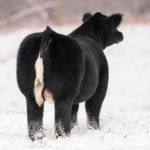As the winter months set in, we are faced with all of the nasty things that we find in the hair and on the hide of show cattle. Of course, all cattle are susceptible to these things, but we are far less concerned with a few spots of missing hair on a feedlot steer than we are of a calf that’s headed to a show in a month.
So which nasty things are we discussing?
Dandruff, ringworm, and lice…yuck!


In Dealing with Dandruff, we discussed in detail many of the things that can cause dandruff in cattle. It is a topic that comes up in many FB groups and it is typically much easier to deal with than the other things we’ll discuss in today’s article. Knowing the cause of whatever dandruff you are dealing with is key.
For example, if you have dandruff because you are not getting the soap rinsed out of them completely, then you may need to change up your routine or even get a soap that rinses more cleanly.
If you see dandruff because of fitting products, you’ll know you need to condition the hide and hair a little better after a show. Regardless of the source, keep in mind, it’s incredibly important to get rid of that dandruff! Let’s explore more in this dandruff, ringworm, and lice triple threat…
Ringworm
Ringworm is not a worm at all, but a fungus that is contagious to other cattle and people. We are constantly experimenting with ways to prevent the spread of ringworm. It is most commonly spread by tools and contact with infected calves. Clipper blades, combs, blower hose nozzles, halters, and show sticks all transfer the spores.
Whenever you remove the calf’s natural oils from his hide, it seems he is more susceptible to exposure. Cattle that are immune-compromised or particularly thin are often the ones we see break with ringworm worse than others.
Ringworm often shows up where the hair is naturally shorter. Around their eyes and muzzle are pretty common places to see it start. Spores may be on the feed bunks or water troughs. Or, they butt heads with a calf that has it and…ta-da! Everyone gets it.
That being said, anywhere you may comb on a calf with an infected comb is likely to break with ringworm! Legs, bellies, tops…everywhere!
Frank is always telling me I’m fighting a losing battle. That doesn’t prevent me from being militant about everyone putting combs in a bleach solution between calves, disinfecting clipper blades, and even soaking the blower hose nozzles. We’ll never prevent it completely, but we can for sure cut down on it.
When it comes to treating ringworm, it’s important to use products that are labeled for cattle. I can make a laundry list of things people use to smother, kill or otherwise get rid of ringworm.
However, keep in mind these are food animals and regulations are strict to protect our food chain and the industry’s integrity. Check with your vet. There are products that work very well, but preventing the spread is most important at our house.
Lice
Have you ever worked on a calf all year only to have him rub off all of the hair on his neck, behind his shoulder, on his tailhead or in his twist the week before a show? If not, consider yourself lucky. Maybe you have a great lice management program…if not, you’ve been lucky.
Try to understand the life cycle of these rotten little parasites. Also, read the drug labels of the dewormers you use. Not all dewormers kill lice and mange mites. In addition, there are both sucking and chewing lice.
A single female adult louse in September can result in 1 million lice by January if not controlled.
– Dr Catangui, MWI Animal Health
A two-step approach is recommended with an initial application killing the adults and nymphs on the animal. Then, follow up in three weeks to kill adults and nymphs that have hatched after the initial application.
Since lice are transmitted from animal to animal, treat every calf on your property at the same time. Otherwise, they will just get reinfested by their neighbors. There is a product called Clean-Up that has an IGR (Insect growth regulator) in it. It breaks the life cycle of the lice. I almost never recommend specific products here, but we are fans of this one.
Mange Mites
There are many different species of mange mites. This article by Merck Animal Health has really good information about mange. We typically see the mange that results in cattle rubbing the hair off in their twists, and above their hocks. I was unaware they could live off of the animal.
We can do a better job treating and preventing parasite infections if we better understand their life cycles.
If you stay on top of all of dandruff, ringworm, and lice, you can certainly manage your show cattle more easily. Be sure that you are using the appropriate products for the specific conditions you see in your cattle. You can check with your veterinarian. Additionally, it’s important that they are appropriate for meat animals.
What are your preferred products to deal with these issues?
Before you leave, please subscribe to our list to be notified of new articles.








